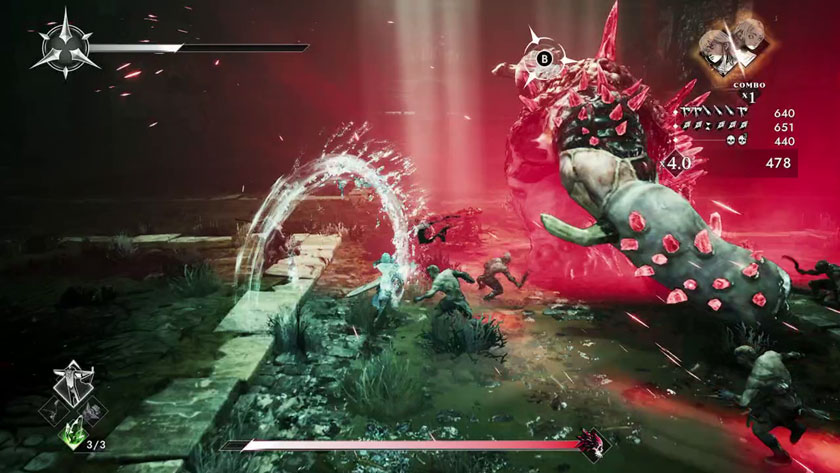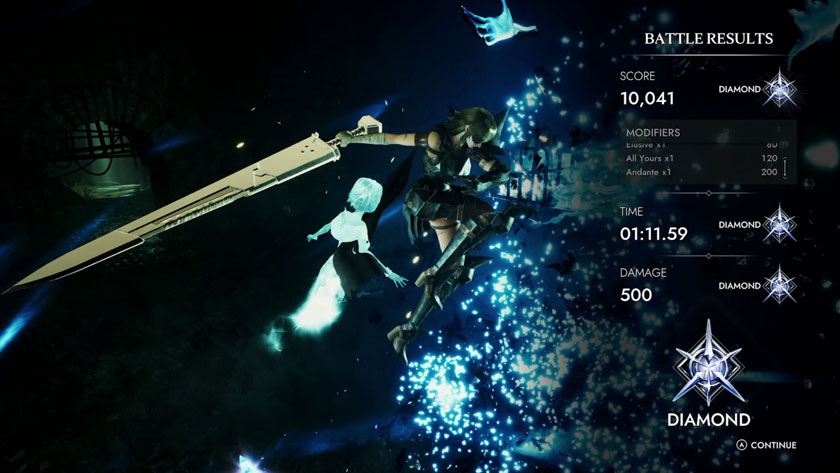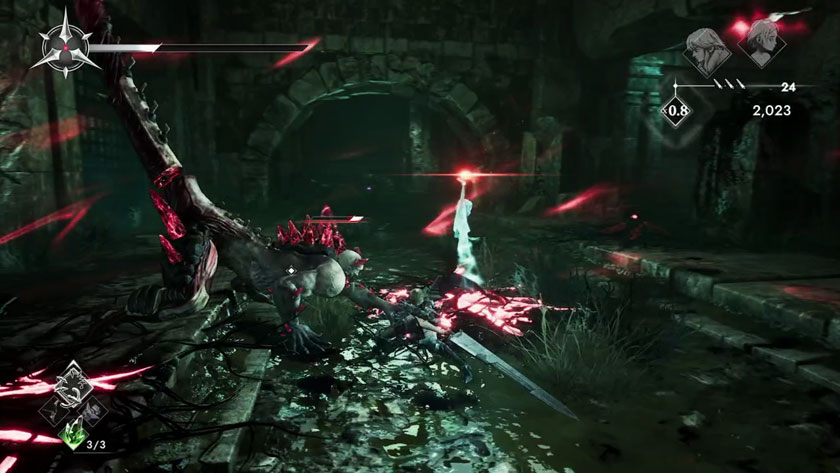Soulstice is Excellent

There are times I have to wonder if my contrarian nature is somehow programmed into me, or if it is a mere coincidence that my tastes often rub more mainstream proclivities the wrong way. To say that I enjoyed Soulstice more than I enjoyed any lone Devil May Cry game is no doubt going to cause many character-action aficionados to scoff, and I most certainly had a better time with it than I had the first two Bayonetta titles. One might even call me “basic” for this feeling.
Admittedly, there are no doubt aspects of Soulstice that hold it back from being “as good” as, say, Devil May Cry 5 on a technical, objective level. Writing, for starters. Building upon the drama established in Devil May Cry 3 and familial lore added in Devil May Cry 4, there’s some sense of climactic finality to Devil May Cry 5 and its memorable characters that leaves fans old and recent with a level of catharsis and closure, and all delivered with a bombastic sense of style that other games fail to approach the imagination of.
Which, perhaps, would be one of the first perceived “failings” of Soulstice. It is far more subdued than its character-action compatriots, relying less on the roller-coaster zaniness and “how much more kuh-razy can these narrative loop-de-loops get?”, delivering instead a somber tale of a young warrior woman and her spectral sister’s bond. Briar is sardonic in expression and speech, contrasting with the innocent optimism and youthful wisdom of her deceased sister. Their mission is to investigate and put an end to the corruption and collapse of one of the world’s great three cities, a dimensional tear having opened above from which wraiths descend upon the populace to slaughter, contaminate, and possess.
Despite the abundance of demons or apocalyptic conflict in Devil May Cry or Bayonetta, respectively, the jovial wit of our protagonists always conveys a sense of fun in the carnage and makes a mockery of the villains responsible. The characters, setting, and narrative of Soulstice do not possess such levity, but I can assure you, the gameplay itself is such a delight that I believe it deserves to be held as an equal sibling to such franchises.

I’ll begin by acknowledging that Soulstice is “easier” than either genre parent in several ways. The first is the limited moveset available to the player, with each weapon sharing the same few button combinations for similar effect. Combining jump and secondary attack buttons will always perform an upward attack move that launches the enemy into the air or, if the player is already in the air, strikes an enemy downwards. One weapon might slam the enemy directly down into the ground while another spins like a saw, but the effect follows a similar logic. With such a small number of combinations and sharing attributes between each weapon, the player is asked to remember far less than character action games typically demand.
The ranking system following each combat encounter could also be considered more generous, though it may simply be that scoring well in regards to combos and time came easy since the emphasis turned to weapon swapping rather than performing a diverse set of attack combinations. However, this also ignores two other factors found in combat rankings: damage suffered and time taken to complete. It is here that we begin to delve into the combat’s greater complexity.
If Devil May Cry 5 locking away lyrics to its music behind high combat rankings was frustrating to inadequately skilled game press, then Soulstice is bound to enrage them further by locking the “Devil Trigger” equivalent and powerful finishing moves behind “unity”; by avoiding damage and unleashing a constant barrage of offensive combos and attacks, Briar and her sister Lute become more synchronized. Once Unity is achieved, the player is free to either perform the longest string combos with any of their weapons, concluding in a powerful area-of-effect strike, or to activate Rapture, which slightly transforms Briar into a more vicious warrior capable of unleashing devastating strikes to her opponents. The benefit of sticking with the finishing moves is that the Unity gauge will still be full upon completion, allowing the player to chain one move after the next so long as they avoid getting hurt or continue dealing damage to their opponents. Rapture, on the other hand, is more capable of clearing out a lot of low-level enemies in a shorter span of time while concluding with a powerful, explosive attack. Once it’s finished, however, unity is reset and must be built back up.

This introduces a sort of “game-within-a-game” that I love so much. Even if a combat encounter isn’t very difficult, my focus instead turns to optimization. Which weapons will allow me to get the most combos that build unity the fastest and therefore allow me to Rapture or perform a finishing combo? In how short a time can I put an end to this combat encounter? Can I avoid damage, finish this quickly, and get a Diamond rank? This has allowed a return to a higher difficulty to remain enjoyable even with the earliest encounters being little challenge. It helps, then, that Soulstice is the first character action game where the prospect of getting Diamond on each level seems achievable for me.
Again, though, this no doubt sounds like an easier time for players of Devil May Cry or Bayonetta. If you have fewer combos needed to perform and just need to avoid damage and weapon swap, where’s the real challenge? That comes in with the color-coded foes not unlike DmC: Devil May Cry, but far more exciting in their execution. Rather than just have the player match the colored weapon or power with the enemy’s, Soulstice has the player project a matching colored field with the sister character Lute. Blue wraiths can only be harmed while inside of this blue field, but the catch is that the longer the field is up, the more “entropy” Lute gathers. Once that entropy overloads, the field drops and Lute is absent for a short period of time. This leaves Briar incapable of harming the wraiths while also keeping her exposed to their attacks. The same occurs when faced with the Possessed, a red color-coded foe that requires a red field to be used by Lute.
There are multiple additional complications to this seemingly simple mechanic. The first is that Lute is also capable of blocking attacks or freezing enemies temporarily should the player press the parry button when prompted. The timing can be tricky, especially when you’re mid-combo surrounded by opponents and have three such prompts appear simultaneously. Certain ability upgrades for Lute will also cause her entropy to increase upon performing specific counter-attacks when parrying, which can lead to the player overloading surprisingly quickly if they’re not carefully reading each upgrade description they purchase. Explosive hazards will also litter some of the combat arenas, with some exploding unless the blue field has been projected, or others exploding so long as the red field is projected. Managing these hazards while simultaneously having to juggle between the fields in order to damage wraiths or possessed while also trying not to overload Lute can become quite the sweaty challenge, especially when you’re then also trying to rank high for that particular battle or chapter.

This is the sort of chaotic combat that I thrive on. Rather than having to memorize attack combinations, I’m instead forced to pay attention to the situation on the battlefield, eyes aware of my surroundings as much as I am the opponent I’m attacking. What’s being tested are my reflexes and ability to make a split decision, not train some combo attacks into my muscle memory. There’s also the different traits of each weapon, such as the gauntlets being useful against armored foes or the whip against crowds, but these are comparatively basic compared to the different situations the player finds themselves in based on the wraiths or possessed present in a given encounter.
Naturally these projected fields are also used in exploration, platforming, and puzzle solving, with the player working their way through each level in order to progress. Be it invisible platforms that only manifest within the blue field, or stalagmites that must be destroyed in quick succession within the red field in order to collapse a barrier blocking the way forward, there are a series of obstacles and hidden paths that yield the way forward or towards secret treasures.
The player isn’t really going to find innovation in the level design, however. Not that these things are executed poorly, though the environments may lack some greater sense of variety. Soulstice takes place in a single city with a very clear aesthetic and visual design to it, and the differences between the lowest slums and highest heights are minimal (especially when they all lie in ruined shambles). The real evolution is within the game’s combat, and to that end it excels greatly.

As regards to the game’s story, it’s tough to really say at this juncture how I feel about it. I was certainly entertained, and I certainly like the protagonists and supporting heroes. This is despite the looping dialogue that occurs between Briar and Lute while exploring, repeated over and over even by the final game’s levels. It feels as if Lute in particular struggled to settle into her “voice”, be it due to the voice actor or the writers. However, before long I had enjoyed the whole of the main cast, with only a couple of villains sounding off (possibly due to their American accents seeming out of place, though I’m not certain).
Really, what had me so interested to see where the next game would go were the revelations of the final few chapters as well as the potential fate of our protagonists. It is quite possible that the sequel to Soulstice — and the ending is certainly left on a cliffhanger intent on a sequel — might even place the player in a different character’s shoes than Briar and Lute. That I’m left so curious as to want the sequel now is something that happens quite rarely in video games for me, but by the game’s finale I was enraptured not just by the combat mechanics, but where this setting and characters were going.
I cannot say that Soulstice is going to delight character-action fans as much as the Devil May Cry or Bayonetta serieses, nor can I say it’s more “accessible” to less skilled fans due to all the combat situations they have to keep track of. I just know the game appeals to my specific sensibilities so much that I cannot help but hype it up. This game only costs $39.99 USD, and it is far more polished and better designed than many $59.99 AAA releases these days.
It’s hard not to want to back the underdog in such a scenario and declare it as an under-appreciated great. If you like action games, then I think Soulstice deserves your time and attention.


